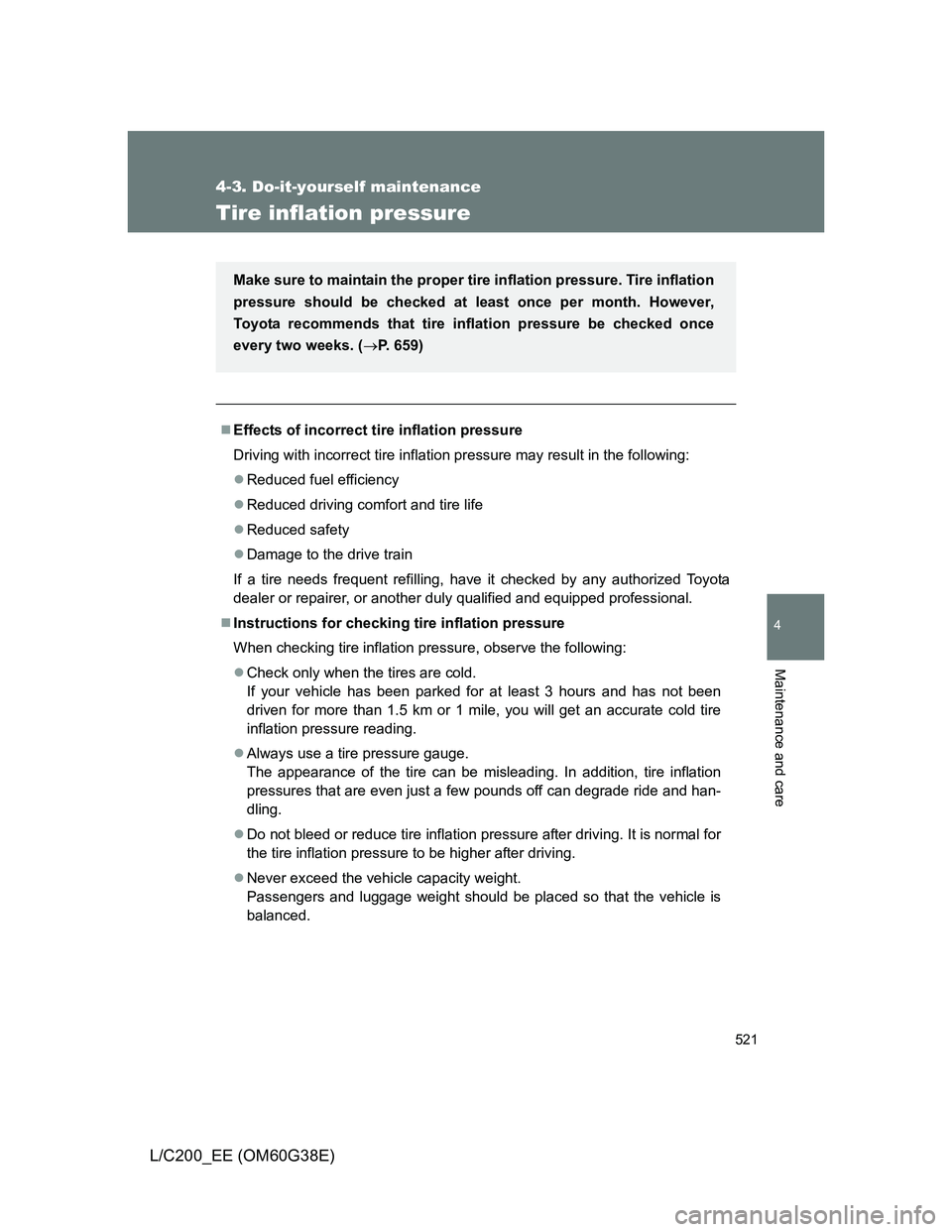Page 9 of 692
9
L/C200_EE (OM60G38E)
: If equipped
Tires
Rotation
Replacement
Inflation pressure
P. 518
P. 596
P. 521
Back door P. 63
Side doors P. 60Fuel filler door
P. 116
Rear turn signal lights P. 200
Rear window wiper
P. 231
Rear window defoggerP. 356
License plate lights P. 218
Stop/tail lights P. 218
Rear fog lights P. 222
Page 488 of 692

488
L/C200_EE (OM60G38E)
4-1. Maintenance and care
Cleaning and protecting the vehicle exterior
Automatic car washes
Fold the mirrors back before washing the vehicle.
Brushes used in automatic car washes may scratch the vehicle surface
and harm your vehicle’s paint.
High pressure car washes
Do not allow the nozzles of the car wash to come within close proximity
of the windows.
Before car wash, check that the fuel filler door on your vehicle is closed
properly.
Touch-up paint (if equipped)
Touch-up paint may be used to cover small chips or scratches.
Apply the paint soon after the damage occurs or corrosion may set in. To
apply the touch-up paint so it is hardly noticeable, the trick is to apply it only
to the bare spots. Apply only the smallest amount possible and do not paint
the surface around the scratch or chip.
Perform the following to protect the vehicle and maintain it in prime
condition.
Working from top to bottom, liberally apply water to the vehicle
body, wheel wells and underside of the vehicle to remove any
dirt and dust.
Wash the vehicle body using a sponge or soft cloth, such as a
chamois.
For hard-to-remove marks, use car wash soap and rinse thor-
oughly with water.
Wipe away any water.
Wax the vehicle when the waterproof coating deteriorates.
If water does not bead on a clean surface, apply wax when the vehicle
body is cool.
Page 521 of 692

521
4-3. Do-it-yourself maintenance
4
Maintenance and care
L/C200_EE (OM60G38E)
Tire inflation pressure
Effects of incorrect tire inflation pressure
Driving with incorrect tire inflation pressure may result in the following:
Reduced fuel efficiency
Reduced driving comfort and tire life
Reduced safety
Damage to the drive train
If a tire needs frequent refilling, have it checked by any authorized Toyota
dealer or repairer, or another duly qualified and equipped professional.
Instructions for checking tire inflation pressure
When checking tire inflation pressure, observe the following:
Check only when the tires are cold.
If your vehicle has been parked for at least 3 hours and has not been
driven for more than 1.5 km or 1 mile, you will get an accurate cold tire
inflation pressure reading.
Always use a tire pressure gauge.
The appearance of the tire can be misleading. In addition, tire inflation
pressures that are even just a few pounds off can degrade ride and han-
dling.
Do not bleed or reduce tire inflation pressure after driving. It is normal for
the tire inflation pressure to be higher after driving.
Never exceed the vehicle capacity weight.
Passengers and luggage weight should be placed so that the vehicle is
balanced.
Make sure to maintain the proper tire inflation pressure. Tire inflation
pressure should be checked at least once per month. However,
Toyota recommends that tire inflation pressure be checked once
every two weeks. (P. 659)
Page 692 of 692
692
L/C200_EE (OM60G38E)
GAS STATION INFORMATION
Fuel filler door
P. 1 1 6Auxiliary catch lever
P. 501
Tire inflation pressure
P. 6 5 9
Fuel filler door opener
P. 1 1 6
Hood lock release lever
P. 501
Fuel tank capacity (Reference) 93 L (24.5 gal., 20.4 Imp.gal.)
Fuel type P. 648
Cold tire inflation
pressureP. 6 5 9
Engine oil capacity
(Drain and refill —
reference)
Gasoline engine L (qt., Imp.qt.)
With filter 7.5 (7.9, 6,6)
Without filter 7.1 (7.5, 6.2)
Diesel engine L (qt., Imp.qt.)
With filter 9.2 (9.7, 8.1)
Without filter 8.2 (8.7, 7.2)
Engine oil type P. 649